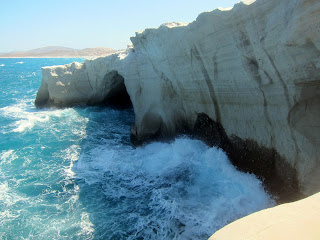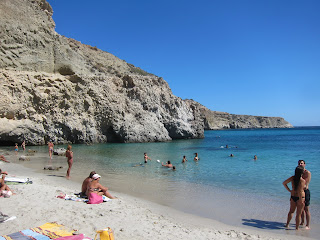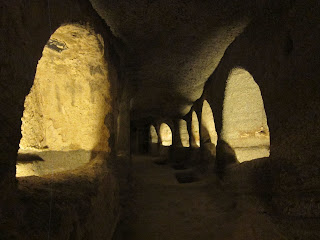Sarakino beach in Milos is amazing. It's completely unlike any beach I've ever seen. I would guess that there's not another beach like it in the world. Before we went, I saw some websites describing the experience of Sarakino as like walking on the moon. As I was leaving Sarakino that day, I had a slightly different feeling about it. It was more like if scientists in the '40's had erroneously reported the existence of a beach on the moon, then Walt Disney had put his wildest imaginings into recreating the lunar beach experience on Milos. I also had the idea that Disney's artists might have created their lunar beach prototypes with soft-serve vanilla ice cream. Check out the pictures below to see where I got these impressions.
Here you can see the sort of valley that runs down to the beach at Sarakino. There are cliff-like walls on the left, vegetation along the bottom and rocky hills to the right (mostly blocked by our heads). Directly to the left of my forehead you can see the small inlet of water at Sarakino beach.
That picture is taken from where you'll park, so it's a bit of a walk down to the water. The walk is physically pretty easy, but it takes a bit of trial and error to find the best way down to the beach.
Above you can see my wife, her sister and both her parents working their way down.
And here you can see a close up of one of the lava sculptures (soft-serve vanilla?) on the way down to the beach, and in the background, a glimpse of the beach itself.
This gives a better view of how the water runs from the sea in the upper right, in a narrow channel inland to the lower left. The full length of this channel is roughly double what you can see here.
This is taken at the end of the channel, looking back toward the sea. So you can see that swimming isn't really Sarakino's strongest feature. We didn't go in the water at all. But it has a big shallow area, which would be good for small children. And it's well protected from the wind, which means it's swimmable even with heavy winds blowing out of the north, like we had the entire week we were in Milos. Those winds were a problem at a lot of other northern beaches, but it made for some visually dramatic waves at Sarakino, as you can see below.
The seawater flows from the lower left, under the lava and into the bowl-like formation to the right. The picture below is a close up view showing the tunnel the water flows through.
Here's are a few pictures along my walk back from the west end of Sarakino.
This gives some sense of perspective as to how expansive Sarakino is. All those little specks are people exploring the area, and there was still quite a bit of Sarakino behind my back when I took this picture. (I'm facing east here.)
I have to say, this last one was really surprising-- a door carved into the side of the cliff wall. I walked in and the tunnel went back maybe 20 feet before turning left. Then that tunnel connected up with a few others going deeper into the rock. I couldn't really figure out why the tunnels had been built. There seemed to be lots of long hallways, but no rooms. Someone else at the beach seemed to think it was an old mine. If so, it was a very small scale mine, which suggests it is probably very old. I don't know. The mine story makes more sense than any explanation I can think of, but it still seems odd.
That's all I have for Sarakino. It really is the most amazing of Milos' many great beaches. Even if you're not going to swim, make sure to set aside at least an hour to explore.
That picture is taken from where you'll park, so it's a bit of a walk down to the water. The walk is physically pretty easy, but it takes a bit of trial and error to find the best way down to the beach.
Above you can see my wife, her sister and both her parents working their way down.
And here you can see a close up of one of the lava sculptures (soft-serve vanilla?) on the way down to the beach, and in the background, a glimpse of the beach itself.
This gives a better view of how the water runs from the sea in the upper right, in a narrow channel inland to the lower left. The full length of this channel is roughly double what you can see here.
This is taken at the end of the channel, looking back toward the sea. So you can see that swimming isn't really Sarakino's strongest feature. We didn't go in the water at all. But it has a big shallow area, which would be good for small children. And it's well protected from the wind, which means it's swimmable even with heavy winds blowing out of the north, like we had the entire week we were in Milos. Those winds were a problem at a lot of other northern beaches, but it made for some visually dramatic waves at Sarakino, as you can see below.
Below you can see a little to the East of the above shot, where the waves break against much higher natural sea walls.
And below are a couple of shots from the far opposite (west) end of Sarakino.
These natural sea walls extend a kilometer or more from east to west, with just a short break to form the beach inlet of Sarakino. On the way back from the west toward the main beach there's this "toilet bowl" formation in the lava. (I apologize for not conceiving a more complementary nickname, but nothing else seems quite as appropriate.)This gives some sense of perspective as to how expansive Sarakino is. All those little specks are people exploring the area, and there was still quite a bit of Sarakino behind my back when I took this picture. (I'm facing east here.)
That's all I have for Sarakino. It really is the most amazing of Milos' many great beaches. Even if you're not going to swim, make sure to set aside at least an hour to explore.













































